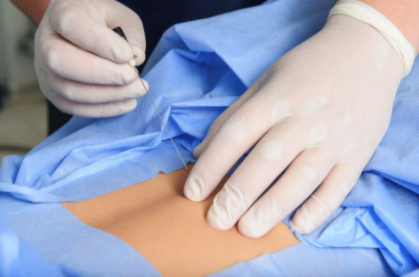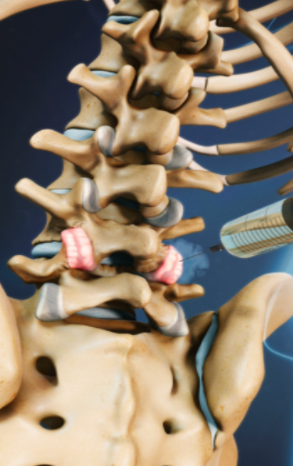Facet Injection
Facet Injection
ALL THE INFORMATION YOU REQUIRE REGARDING FACET JOINT INJECTIONS
Injectable facet blocks are frequently prescribed to Relevium patients who suffer from back and neck pain. Facet joints may experience discomfort as a result of factors such as back injuries, facet joint arthritis, or mechanical stress to the back. In addition to being administered in and around facet joints, these injections reduce inflammation and irritation caused by arthritis discomfort.
WHAT SYMPTOMS ARE MOST OFTEN PRESENTED IN FACET DISEASE?
Flexibility issues with the vertebrae are the most prevalent manifestation of facet disease. Individuals diagnosed with cervical facet syndrome may encounter difficulties performing leftward or radial neck twists or turns. Conversely, individuals afflicted with lumbar facet syndrome might encounter challenges in initiating flexion or rising from a seated position.

The seven most prominent signs of FACET JOINT PAIN are as follows:
- A painful sensation in the upper, middle, or lower back
- Muscle numbness, pain, and fatigue
- Anxiety when attempting to bend forwards or backwards
- Lumbar facet syndrome—back discomfort that radiates to the back of the legs or buttocks—may be experienced.
- Cervical facet syndrome is characterized by neck discomfort that may radiate to the arms or shoulders.
- Headaches or ringing in the ears that are situated behind the eyelids
- Spinal abnormalities including scoliosis, lordosis, and kifosis
WHAT IS FACET JOINT INJECTION?
Facet blocks, which are facet joint injections, have been utilized to alleviate back pain and/or to ascertain whether the facet joint is the source of the discomfort. Injecting a local anesthetic (numbing agent) into one or more of the minor joints situated along the periphery of each vertebrae on both sides of the lumbar spine is the initial step in lumbar facet joint blocks. The necessity for multiple injections may vary depending on the number of joints involved.

Facet joints are located in the posterior compartment of the spinal column. They provide stability and range of motion, allowing the spine to bend and twist. These joints can become sensitive and painful following direct wear and tear, inflammation, or injury. This can occur at any level of spine, but is most common in the cervical spine (neck) or lumbar spine (lower back).
TOP 5 BENEFITS OF FACET JOINT INJECTION
Based on the outcome of a facet joint nerve block, if the patient gets sufficient relief of pain but the pain reappears again, the surgical treatment may be needed.
Here are the most common benefits:
- Combination of long-lasting steroid and anesthetic medication is injected to numbing the joint for pain relief
- Fluoroscopy guidance is used for precise accuracy of the needle to the inflamed or irritated joints
- Outpatient procedure done in the office, takes approximately 30 minutes
- Maximum pain relief can take a few days and lasts up to 1.5 years
- Helps to delay or avoid surgery
If you are experiencing Low Back Pain, then contact Relevium to book in for an appointment and find out more about how we can support you in the treatment of your condition.
WHAT IS MEDIAL BRANCH BLOCK?

Facet joints are well supplied by the medial branches of the dorsal rami, and can be subjected to significant strain during spine loading. Degenerative changes in the posterior lumbar facet joints have been recognized as a source of low back pain that may radiate to the leg. Pain impulses from the medial branches of lumbar dorsal rami can be interrupted by blocking these nerves with anesthetic agent (facet block) or coagulating them with a radiofrequency wave (radiofrequency facet denervation). Similar to facet joint injection, medial branch injection is an injection placed outside the joint where the medial branch nerve is located. Both types of injections usually result in a quick reduction in pain, increased function and mobility, and less need for pain medication. Typically, facet joint blocks are performed as a part of a work-up or diagnostic and therapeutic tool for back or neck pain. Pain relief following a precise injection of local anesthetic confirms the facet joint as the source or generator of pain. For determining an accurate location for injection therapy and to avoid complications such as bleeding or infection, spinal injections are usually performed primarily by fluoroscopic guidance.
What to expect from a facet block injection
The injection itself will only take at most a few minutes and the entire procedure usually takes between twenty and thirty minutes. The injection procedure includes the following steps:
- Commonly, the procedure is performed without any sedation, however, an IV line can be started if relaxation medicine is needed.
- The patient will lay on a procedure table, and the skin over the area to be tested will be well cleansed.
- The physician will treat a small area of skin with a numbing medicine, which may sting for a few seconds.
- The physician will then use an X-ray to guide their procedure (fluoroscopy) to direct a very small needle into the facet joint.
- A small amount of contrast dye is then injected to confirm that the needle is in the joint and that medication is contained inside the joint.
- A small amount of anesthetic and then a steroid or anti-inflammatory medication is slowly injected into the joint.
Benefits
If the facet joints that were treated are the source of the pain, the patient will have immediate pain relief from the local anesthetic and may begin to notice longer lasting pain relief from the steroid starting two to five days after the injection which can be very helpful to carry on virtually pain free in their daily lives.
How do the facet joints work
The facet joints are paired joints in the back and neck, one pair at each vertebral level (one joint on each side of the vertebrae). These specific joints have a cushioning tissue between the bones that is filled with a synovial fluid, which reduces friction between bones that rub together.
How many treatments do I need
If the facet block procedure is effective in alleviating the patient’s back pain, it is often considered reasonable for the procedure to be done up to three times per year. Some patients can get a radiofrequency procedure if the medial branch block is successful.
When will I feel better
As the numbing medicine wears off patients may feel a slight increased pain that can last for several days before the actual cortisone starts to take its lasting effects. Take note of these results a week after the injection:
- Within the first two to three days, if the treated area feels uncomfortable after the injection, apply an ice pack to the area that was injected and this will typically provide a temporary relief of pain. Patients may continue to take their regular pain medicine after the procedure unless the doctor advises otherwise.
- Patients may return to their regular activities on the day after the procedure.
- Patients may be referred for manual therapy or physical therapy after the injection.
- When the patient’s pain is improved, it will be advised to begin a regular exercise routine and add active activities in the patient’s life with moderation to help keep the bones and joints working effectively and not put under too much strain. Even if the pain relief is significant, it is still important to increase activities gradually over one to two weeks to avoid recurrence of pain or causing further pain.
Is this procedure right for me?
Yes, if you have arthritis, low back pain, and even sciatica the procedure is for you. Chronic back pain and living with chronic pain can be fixed with a facet injection.
What are the risks
If the first facet joint injection does not relieve the patient’s pain, then the doctor may decide to not repeat the injection. As with all procedures, there are always complications and potential risks with facet joint injections because it is puncturing the skin so make sure you go to the best doctor for you. However, this risk is low and complications are rare.

